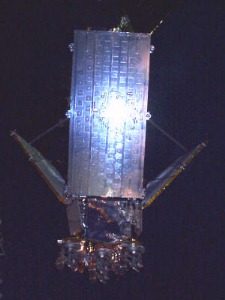Iridium Flares
What is a flare?
Satellites orbiting the Earth have no light of their own, so are visible to an observer only if they reflect sunlight. This will usually just be a diffuse reflection which, as most satellites aren't that large, will mean they are not particularly bright. However, if there are any extensive flat surfaces on the satellite and the Sun reflects from these surfaces directly into the viewer's eyes it will be spectacularly bright - this is known as a "flare". A flare is not just a "flash" though - they build from nothing to maximum brightness and then fall away to nothing again as the alignment with the Sun becomes established and then breaks down. This gives photographs of flares much more interest than those of satellite trails, which are usually of constant brightness along their length.
 The most famous flares were produced by the first generation of the Iridium constellation of communications satellites. They were particularly good at flares, having three large flat antennae which, as part of their operational procedures, were kept facing in a constant direction relative to their orbit track (see picture on right). This means that not only were the flares bright but they were also highly predictable, the one factor that is usually variable (the orientation of the satellite) being exactly known. They were also frequent, as there were sixty-six active satellites in the constellation (plus some "in-orbit spares"). The area on the Earth that can see any given flare was small though (as the Sun-satellite-observer geometry must be very precise) and they lasted no more than 30secs (for the same reason, given that the satellite is, of course, moving), so to find out where and when they would occur it was imperative to use a prediction program such as heavens-above.com.
The most famous flares were produced by the first generation of the Iridium constellation of communications satellites. They were particularly good at flares, having three large flat antennae which, as part of their operational procedures, were kept facing in a constant direction relative to their orbit track (see picture on right). This means that not only were the flares bright but they were also highly predictable, the one factor that is usually variable (the orientation of the satellite) being exactly known. They were also frequent, as there were sixty-six active satellites in the constellation (plus some "in-orbit spares"). The area on the Earth that can see any given flare was small though (as the Sun-satellite-observer geometry must be very precise) and they lasted no more than 30secs (for the same reason, given that the satellite is, of course, moving), so to find out where and when they would occur it was imperative to use a prediction program such as heavens-above.com.
The prediction program also told you the exact direction and altitude you had to look to see the flare as this varied considerably with time of day & season. The flare magnitudes were also highly variable, mainly depending on how far the observer is away from the line of perfect alignment - at their brightest, flares were 40 times brighter than Venus and could be seen in broad daylight! Even a "dim" one was brighter than almost every star in the sky so they were well worth looking out for.
Unfortunately, the first generation satellites have now been replaced with more capable versions which do not have the same type of antennae and so do not produce flares - the descriptions in this section thus refer only to the earlier generation. Flares are sometimes produced by other satellites though so if you keep your eyes to the sky you might just catch one of these dramatic events.
There's a lot more to more to be said about the periodicities exhibited by Iridium flares, so I've placed that discussion, together with more information on the visibility of the ISS, in an article within the Astronomical Theory section of this website. There's a link to this section at the bottom of the previous page.
 The most famous flares were produced by the first generation of the Iridium constellation of communications satellites. They were particularly good at flares, having three large flat antennae which, as part of their operational procedures, were kept facing in a constant direction relative to their orbit track (see picture on right). This means that not only were the flares bright but they were also highly predictable, the one factor that is usually variable (the orientation of the satellite) being exactly known. They were also frequent, as there were sixty-six active satellites in the constellation (plus some "in-orbit spares"). The area on the Earth that can see any given flare was small though (as the Sun-satellite-observer geometry must be very precise) and they lasted no more than 30secs (for the same reason, given that the satellite is, of course, moving), so to find out where and when they would occur it was imperative to use a prediction program such as heavens-above.com.
The most famous flares were produced by the first generation of the Iridium constellation of communications satellites. They were particularly good at flares, having three large flat antennae which, as part of their operational procedures, were kept facing in a constant direction relative to their orbit track (see picture on right). This means that not only were the flares bright but they were also highly predictable, the one factor that is usually variable (the orientation of the satellite) being exactly known. They were also frequent, as there were sixty-six active satellites in the constellation (plus some "in-orbit spares"). The area on the Earth that can see any given flare was small though (as the Sun-satellite-observer geometry must be very precise) and they lasted no more than 30secs (for the same reason, given that the satellite is, of course, moving), so to find out where and when they would occur it was imperative to use a prediction program such as heavens-above.com.